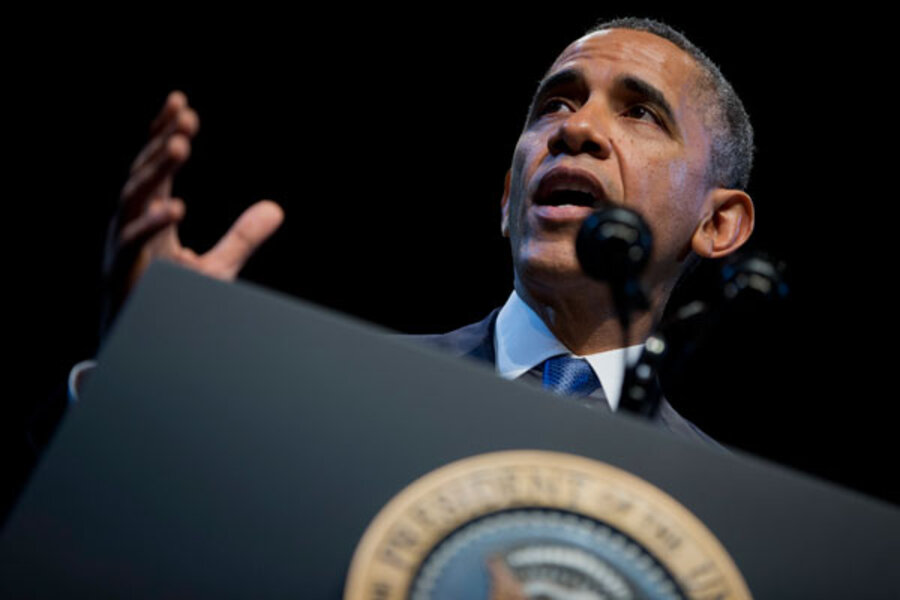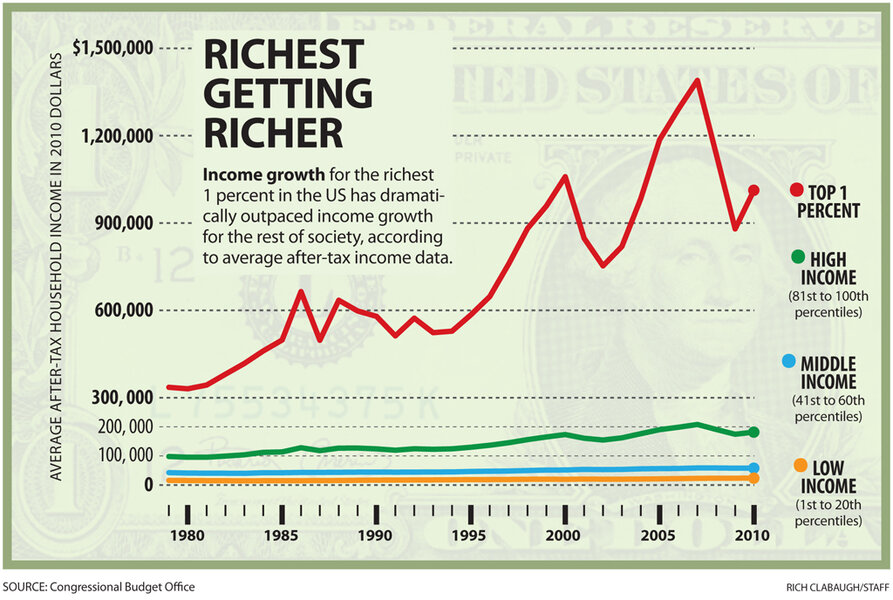Is income inequality as bad as Obama says? In many ways, yes.
Loading...
| Washington
As Washington returns to business this week, Democrats are primed to make income inequality their top campaign issue of 2014.
President Obama is doing his part to push the issue to the top of the national agenda, too, recently calling it “the defining challenge of our time.”
But such sweeping rhetoric, along with vague generalizations spouted by partisans on both sides of the issue, can make it hard to get a handle on how big America's income gap is, and to what degree the rich are truly leaving the rest of American behind.
Americans have a general perception: Some 76 percent of respondents agreed that the “rich just get richer” and the “poor get poorer” in a 2012 Pew Research Center poll. And in a 2013 Pew poll, almost half said the wealth gap is a very big problem.
Data support many of those concerns.
The income gap between rich and the middle class or poor has widened during the past three decades. CEO pay has surged. And it’s also true that millions of Americans who view themselves as middle- or working-class are struggling financially in the current economy.
Why has the income gap widened since the 1970s? Many economists emphasize a mix of reasons that include, prominently, how technology has affected the marketplace value of various occupations. In general, new tools of productivity have benefited the most educated workers, while automating some middle-tier jobs out of existence.
Other forces may have also played a big role, from tax changes that disproportionately benefited the rich to rising global competition in the labor market. Recent decades have also seen a decline in the share of workers represented by union collective bargaining, and a decline in the minimum wage relative to inflation.
But a broad look at the numbers shows that there are nuances in the rich-get-richer story.
It’s probably not true, for one thing, to say that “the poor get poorer” these days. Rather, some studies conclude that, when you divide the income ladder into fifths, all groups have been gaining in their disposable income – what they have each month after taxes are paid. And all have gained in the volume of goods and services they are able to consume.
The Congressional Budget Office, for example, has pegged middle-class income growth at about 1 percent per year between 1979 and 2010, not a trivial growth rate for a period that’s widely considered an era of wage stagnation.
In addition, there’s some complexity at the upper end of the money scale. Although the share of US income going to the top 1 percent has doubled since 1979, their share of the nation’s wealth has not surged as dramatically. It went from 33.4 percent of US wealth in 1962 to 35.4 percent in 2010, by one analysis.
Compared with other advanced nations, the US has higher inequality of incomes, and inequality in the US has been rising a bit faster than in those other countries. The so-called Gini coefficient, a measure of inequality on a spectrum where “0” means all incomes are equal and “1” means one person has all the income, finds America with a 0.38 reading. That compares with 0.316 for the 20 founding nations of the Organization for Economic Cooperation and Development, according to OECD data for 2010. (The founding nations are all from the West and heavily European.)
Here’s how the inequality trend has played.
The rich
Back in 1979, it took $336,000 to be counted in the top 1 percent of households by income, according to analysis published last month by the Congressional Budget Office (CBO).
That year is a watershed for economists who study inequality. Before it came a post-war era when, by and large, all income groups saw their fortunes rise together in concert. From 1979 on, though, inequality has widened and average households have struggled harder to get ahead.
By 2010, the average income of a household in the top 1 percent had jumped to $1 million. Their incomes have been rising more than three times as fast as incomes in the middle tier.
If you’re CEO of one of America’s top-selling 350 firms, pay is higher still. Compensation in 2012 averaged $14 million for that group, including the value of exercised stock options, according to research by the Economic Policy Institute, a labor-leaning research group. That’s 273 times the pay of a typical worker, up from CEO pay that averaged 29 times worker wages in 1978.
Amid the up-and-down swings (high-end income was hit along with others in the financial crisis) the long trend for the richest Americans is upward. They’ve gained from a generally low-tax political climate and from the shifts in the economy that have offered opportunities to the educated even as many middle-rung jobs are automated out of existence.
Still, this isn’t a monolithic or permanent group. Entrepreneurs and itinerant executives can pop in and out of the “top 1 percent.”
In fact, it’s worth noting that the group of highest income Americans doesn’t overlap precisely with the group of Americans who have amassed the most wealth in financial portfolios. (Think of it more as two groups that share about half the same members.)
But the consolidation of wealth at the top has accelerated in recent years. The top 1 percent (by wealth) had 35.4 percent of household net worth in 2010. And the top 10 percent, collectively, have gained in recent decades to account for three-quarters of US wealth, according to research by Ed Wolff of New York University.
That wealth share for the top 1 percent has been as high as 38.1 percent, in 1998. And it may have climbed back again since 2010, as the stock market’s post-recession rebound has brought indexes like the Dow Jones Industrial Average to new record highs.
The middle class
Average income for the middle fifth of American households was $57,900 in 2010, compared with $42,600 back in 1979 (after adjusting for inflation), according to the CBO.
Americans in the middle tier have been struggling not just in the wake of the recession but also in a longer-run race to keep up with changes in the workplace – everything from wobbly job security to less-certain retirement benefits.
Some statistics on this group’s financial health point to stagnation. Census income numbers show “down” years battling “up” ones to a draw since the late 1980s. The group’s share of Americans’ net worth took a beating in the recession, and its income as of 2010 hadn’t recovered to pre-recession levels.
But on the income side, many economists see evidence that middle class fortunes have generally been improving. The group’s backsliding in relative terms (in other words, a shrinking slice of the nation’s income “pie”) doesn’t mean an absolute decline in income.
The overall size of the US income pie has been growing, and the middle fifth of Americans has seen its average income rise by 1 percent a year since 1979, according to CBO numbers that factor in taxes (including tax credits) and government transfer payments such as Social Security.
That’s slower than in the pre-1979 period, but not long-term stagnation.
Cornell University economist Richard Burkhauser and colleagues came to similar conclusions in a 2011 study, while some other research finds much smaller (but still positive) gains.
If the middle class has managed to gain some financial yardage, that doesn’t mean all households feel it.
In Pew polling, many Americans feel pretty good about their personal finances, but a 2012 survey of adults who describe themselves as middle-class found 85 percent saying it is harder now than a decade ago to maintain a middle-class living standard.
Where the dominant asset on the balance sheet of “top 1 percent” households is typically equity in a business, for middle class families it’s usually a home, followed by a retirement account.
The housing bust put about 1 in 4 mortgage borrowers into a negative equity position, with a loan balance higher than the diminished value of their home. That problem has begun to ease, but lingers as a concern for several million households.
Meanwhile, jobs that offer a pension and health benefits are harder to come by than they used to be.
The poor
The bottom fifth of US households averaged $23,700 in income for 2010, up from $15,900 in 1979. As with the other CBO numbers highlighted in this article, that’s an after-tax figure that includes transfer payments from government programs as well as wages.
Within this group, the lowest-income segment represents households in or near poverty. (The nation’s official poverty rate is 15 percent as of 2012.)
The poor have essentially tread water during the past three decades, some studies suggest. Disposable-income gains for the bottom 10 percent of households has been just 0.15 percent a year from 1985 to 2010, according to a 2012 study by the University of Wisconsin’s Timothy Smeeding, along with Jonathan Fisher and David S. Johnson of the Census Bureau.
Just as “the rich” is a fluid club at the top, Americans labeled “the poor” are not a group of people who all reside permanently at the bottom rung.
But Mr. Obama recently drew attention to a troubling trend: diminished upward mobility in a nation that has long prided itself as being a “land of opportunity.” He noted that the ability of young people to climb upward economically now appears to be hampered, for the poor especially, by problems such as absent fathers, weak schools, and lack of attachment to institutions including churches and community groups.
Scholars find that in the US it is relatively hard for people to climb from one income class to another. There's mobility, but the correlation of income levels between parent and child tends to be closer in the US than in most OECD nations.
While the top income group in the US holds most of the nation’s wealth, the bottom 20 percent has long had a slightly negative net worth, according to Professor Wolff’s analysis, which draws on Federal Reserve surveys of households. That means debts outweigh assets for the group as a whole.
Low-income Americans are likelier to be renters than homeowners, and are likelier than other Americans to confront severe housing-cost challenges. Some 2 in 3 households with incomes below $15,000 pay at least half their income for housing, the Harvard Joint Center for Housing Studies reports.









